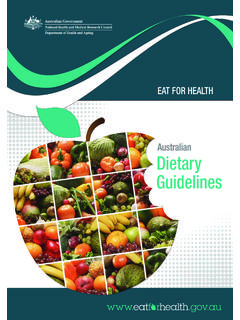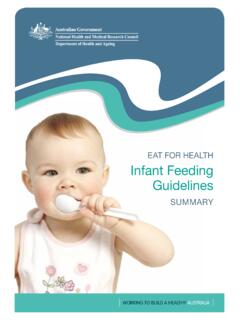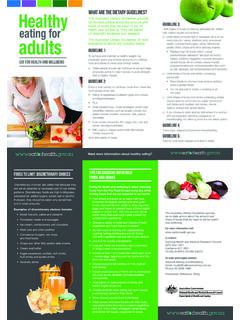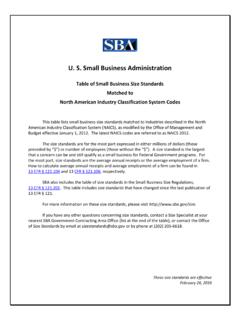Transcription of Healthy uidelines G dietary the are hat Healthy
1 Foods to limit: discretionary choices Discretionary choices are called that because they are not an essential or necessary part of our dietary patterns. Discretionary foods are high in kilojoules, saturated fat, added sugars, added salt, or alcohol. If chosen, they should be eaten only sometimes and in small of discretionary choices include: Sweet biscuits, cakes and desserts Processed meats and sausages Ice-cream, confectionery and chocolate Meat pies and other pastries Commercial burgers, hot chips, and fried foods Crisps and other fatty and/or salty snacks Cream and butter Sugar-sweetened cordials, soft drinks and sports is also important to remember that young children (less than 3 years of age) can choke on hard foods. To prevent this from happening: Sit with them when they eat and don t give them hard foods such as popcorn, nuts, hard confectionary or crisps.
2 Cook or grate hard fruit and vegetables to soften them. Remove all bones from fish or 3: Limit intake of foods containing saturated fat, added salt, added sugars and Limit intake of foods high in saturated fat such as many biscuits, cakes, pastries, pies, processed meats, commercial burgers, pizza, fried foods, potato chips, crisps and other savoury snacks. Replace high fat foods which contain predominately saturated fats such as butter, cream, cooking margarine, coconut and palm oil with foods which contain predominately polyunsaturated and monounsaturated fats such as oils, spreads, nut butters/pastes and avocado. Low fat diets are not suitable for children under the age of 2 years. b. Limit intake of foods and drinks containing added salt. Read labels to choose lower sodium options among similar foods. Do not add salt to foods in cooking or at the Limit intake of foods and drinks containing added sugars such as confectionary, sugar-sweetened soft drinks and cordials, fruit drinks, vitamin waters, energy and sports 4: Encourage, support and promote 5: Care for your food; prepare and store it are the dietary Guidelines?
3 The Australian dietary Guidelines provide up-to-date advice about the amount and kinds of foods that we need to eat for health and wellbeing. They are based on scientific evidence and Australian dietary Guidelines of most relevance to children are included below:Guideline 1: To achieve and maintain a Healthy weight, be physically active and choose amounts of nutritious food and drinks to meet your energy needs. Children and adolescents should eat sufficient nutritious foods to grow and develop normally. They should be physically active every day and their growth should be checked 2:Enjoy a wide variety of nutritious foods from these five food groups every day: Plenty of vegetables of different types and colours, and legumes/beans Fruit Grain (cereal) foods, mostly wholegrain and/or high cereal fibre varieties, such as breads, cereals, rice, pasta, noodles, polenta, couscous, oats, quinoa and barley Lean meats and poultry, fish, eggs, tofu, nuts and seeds, and legumes/beans Milk, yoghurt, cheese and/or their alternatives, mostly reduced fat (reduced fat milks are not suitable for children under the age of 2 years)And drink plenty of more information about Healthy eating?
4 EncouraGinG Healthy habits Childhood is a time of learning. Children who grow up in families that enjoy a variety of nutritious foods from the Five Food Groups are more likely to make their own Healthy choices as they get older. You can help by teaching your whole family to: Choose everyday foods for home and school from the Five Food Groups. Save discretionary choices for special occasions. Provide a variety of types and colours of fresh vegetables and fruit that are in season. Enjoy reduced fat varieties of milk, yoghurt and cheese (once they are 2 years or older). Eat mainly wholegrain cereal foods and breads. Drink plenty of water instead of sugary drinks like cordial, energy drinks, sports drinks, fruit drinks, vitamin waters and soft drink. Eat a Healthy breakfast every day. Learn about how foods are grown and where they come from. Try new foods and recipes help with cooking and preparing foods and drinks too.
5 Turn off the tv and computer at mealtimes make this family time. Wash their hands before eating or cooking. Be physically active play outside, walk the dog or run around at the local Australian dietary Guidelines provide up-to-date advice about the amount and kinds of foods that we need to eat for health and more information contact:National Health and Medical Research CouncilGPO Box 1421 Canberra ACT 260113 000 NHMRC (13 000 64672)To order print copies contact:National Mailing and MarketingEmail: 02 6269 1080 Publication Reference: N55f Cover photo courtesy of the Department of Families, Housing, Community Services and Indigenous Affairsteach your child Healthy habits For a Healthy liFeHealthyeating forchildrenFoods to limit: discretionary choices Discretionary choices are called that because they are not an essential or necessary part of our dietary patterns. Discretionary foods are high in kilojoules, saturated fat, added sugars, added salt, or alcohol.
6 If chosen, they should be eaten only sometimes and in small of discretionary choices include: Sweet biscuits, cakes and desserts Processed meats and sausages Ice-cream, confectionery and chocolate Meat pies and other pastries Commercial burgers, hot chips, and fried foods Crisps and other fatty and/or salty snacks Cream and butter Sugar-sweetened cordials, soft drinks and sports is also important to remember that young children (less than 3 years of age) can choke on hard foods. To prevent this from happening: Sit with them when they eat and don t give them hard foods such as popcorn, nuts, hard confectionary or crisps. Cook or grate hard fruit and vegetables to soften them. Remove all bones from fish or 3: Limit intake of foods containing saturated fat, added salt, added sugars and Limit intake of foods high in saturated fat such as many biscuits, cakes, pastries, pies, processed meats, commercial burgers, pizza, fried foods, potato chips, crisps and other savoury snacks.
7 Replace high fat foods which contain predominately saturated fats such as butter, cream, cooking margarine, coconut and palm oil with foods which contain predominately polyunsaturated and monounsaturated fats such as oils, spreads, nut butters/pastes and avocado. Low fat diets are not suitable for children under the age of 2 years. b. Limit intake of foods and drinks containing added salt. Read labels to choose lower sodium options among similar foods. Do not add salt to foods in cooking or at the Limit intake of foods and drinks containing added sugars such as confectionary, sugar-sweetened soft drinks and cordials, fruit drinks, vitamin waters, energy and sports 4: Encourage, support and promote 5: Care for your food; prepare and store it are the dietary Guidelines?The Australian dietary Guidelines provide up-to-date advice about the amount and kinds of foods that we need to eat for health and wellbeing.
8 They are based on scientific evidence and Australian dietary Guidelines of most relevance to children are included below:Guideline 1: To achieve and maintain a Healthy weight, be physically active and choose amounts of nutritious food and drinks to meet your energy needs. Children and adolescents should eat sufficient nutritious foods to grow and develop normally. They should be physically active every day and their growth should be checked 2:Enjoy a wide variety of nutritious foods from these five food groups every day: Plenty of vegetables of different types and colours, and legumes/beans Fruit Grain (cereal) foods, mostly wholegrain and/or high cereal fibre varieties, such as breads, cereals, rice, pasta, noodles, polenta, couscous, oats, quinoa and barley Lean meats and poultry, fish, eggs, tofu, nuts and seeds, and legumes/beans Milk, yoghurt, cheese and/or their alternatives, mostly reduced fat (reduced fat milks are not suitable for children under the age of 2 years)And drink plenty of more information about Healthy eating?
9 EncouraGinG Healthy habits Childhood is a time of learning. Children who grow up in families that enjoy a variety of nutritious foods from the Five Food Groups are more likely to make their own Healthy choices as they get older. You can help by teaching your whole family to: Choose everyday foods for home and school from the Five Food Groups. Save discretionary choices for special occasions. Provide a variety of types and colours of fresh vegetables and fruit that are in season. Enjoy reduced fat varieties of milk, yoghurt and cheese (once they are 2 years or older). Eat mainly wholegrain cereal foods and breads. Drink plenty of water instead of sugary drinks like cordial, energy drinks, sports drinks, fruit drinks, vitamin waters and soft drink. Eat a Healthy breakfast every day. Learn about how foods are grown and where they come from. Try new foods and recipes help with cooking and preparing foods and drinks too.
10 Turn off the tv and computer at mealtimes make this family time. Wash their hands before eating or cooking. Be physically active play outside, walk the dog or run around at the local Australian dietary Guidelines provide up-to-date advice about the amount and kinds of foods that we need to eat for health and more information contact:National Health and Medical Research CouncilGPO Box 1421 Canberra ACT 260113 000 NHMRC (13 000 64672)To order print copies contact:National Mailing and MarketingEmail: 02 6269 1080 Publication Reference: N55f Cover photo courtesy of the Department of Families, Housing, Community Services and Indigenous Affairschildreneating forteach your child Healthy habits For a Healthy liFeHealthyFoods to limit: discretionary choices Discretionary choices are called that because they are not an essential or necessary part of our dietary patterns. Discretionary foods are high in kilojoules, saturated fat, added sugars, added salt, or alcohol.








